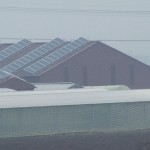It’s not always fun to haul the recycling down from my daughter’s third floor apartment but in Germany I’m told, nothing goes to waste.
She actually has a charming view across her balcony to the farm next door. I’ve enjoyed watching the neighbors walk their dogs and ride their bicycles (despite the February chill) around the freshly ploughed fields.
 I suppose with today’s weather, the farmer was the among the few who truly enjoyed the steady drizzle. I was delighted; however, to see his array of solar panels upon the barn roof and feel certain he and his family also cherish nice sunny weather.
I suppose with today’s weather, the farmer was the among the few who truly enjoyed the steady drizzle. I was delighted; however, to see his array of solar panels upon the barn roof and feel certain he and his family also cherish nice sunny weather.
Gazing further beyond, it’s impossible to miss the high-voltage power line marching across the landscape. The standard household electrical outlet in Germany and most of Europe – packs a wallop of 220-240 volts, twice the standard household voltage in North America. I’m told a normal 110/120-volt electrical appliance designed for use in the US, Canada, or Mexico will provide a nice fireworks display, complete with sparks and smoke, if plugged into a European outlet without a voltage converter.
I’m not sure I’d be far off to guess that fossil fuels play a large part in generating this electricity. So I find the view quite ironic – considering the neighborhood farmer is quietly generating clean power independently.
Photo voltaics or PV is actually still quite expensive. At your home, the more practical choice is solar thermal, or solar hot water.
Typically the system needs only two panels (unlike the PV which takes many of a different sort of panel), a converter, your hot water tank, and a backup heating source.
Currently federal and state tax credits pay for 65% of the system investment. The balance of your costs can be earned back in as little as five years. That gives you and your family about 25 years (or more) of nearly free hot water!
Hey, this solar hot water thing isn’t tree-hugger stuff, it’s simply penny-wise. Just think how ‘smart-like a fox’ the farmer is….
Let me know what you think.
